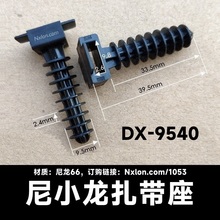Hollow Rivets
©Nxlon.com D/T:

Hollow rivets are a type of connecting piece widely used in modern industry and daily life. The following is a detailed introduction to hollow rivets:
Definition and Structure of Hollow Rivets
Definition: A hollow rivet is a kind of rivet with a hole in the center, mainly used to connect two or more components, achieving a firm connection through the riveting process.
Structure: It is usually composed of a head and a hollow cylindrical shank. The head has various shapes. Commonly seen ones include round head, countersunk head, flat head, pan head, large flange head, etc., to adapt to different connection requirements and installation environments. The hollow structure of the shank is its main feature, which enables it to deform better during the riveting process, adapt to the thickness and shape of the connected materials. At the same time, it also reduces the weight and saves materials.
Features of Hollow Rivets
Lightweight: Due to its hollow structure, compared with solid rivets, the weight is significantly reduced. This is very important for some application scenarios with weight requirements, such as aerospace and electronic devices.
Easy Riveting: When riveting hollow rivets, the shank is easy to deform and can better fill the holes of the connected components, forming a tight connection. Moreover, the riveting process is relatively simple and does not require too much pressure, reducing the difficulty of the riveting operation and the requirements for the equipment.
Reusability: In some cases, hollow rivets can be disassembled through special tools and methods, making it convenient to repair or replace the connected components, and they have a certain degree of reusability.
Good Sealing Performance: When used to connect some components that require sealing, hollow rivets can make the shank deform during the riveting process to better fill the gaps and achieve a good sealing effect.
Manufacturing Standards of Hollow Rivets
The manufacturing of hollow rivets needs to follow relevant national standards and industry standards, such as GB/T 876 - 1986 "Hollow Rivets", etc. These standards clearly specify the dimensions, tolerances, materials, mechanical properties, and surface treatments of hollow rivets. For example, the standards will stipulate the size parameters such as the head diameter, height, shank outer diameter, inner diameter, and length of hollow rivets of different specifications, as well as the mechanical property requirements such as the tensile strength and hardness of the materials.
Materials and Surface Treatments of Hollow Rivets
Commonly Used Materials: Generally, materials such as aluminum alloy, copper alloy, stainless steel, and carbon steel are used for manufacturing. Aluminum alloy hollow rivets are lightweight and have good corrosion resistance, and are often used in fields such as aerospace and electronic devices; copper alloy hollow rivets have good electrical conductivity and thermal conductivity and are suitable for some occasions with requirements for electrical performance; stainless steel hollow rivets have excellent corrosion resistance and high strength and are widely used for connections in harsh environments; carbon steel hollow rivets have a relatively low cost and high strength and are suitable for general industrial and civil fields.
Surface Treatments: In order to improve the corrosion resistance, wear resistance, and aesthetic appearance of hollow rivets, surface treatments are usually carried out on them. Common surface treatment methods include anodizing, electroplating (such as zinc plating, nickel plating, chrome plating, etc.), electroless plating, painting, etc. Anodizing treatment can form a hard, wear-resistant, and corrosion-resistant oxide film on the surface of aluminum alloy hollow rivets; electroplating treatment can form a metal protective film on the surface of the rivets, improving their corrosion resistance and decorative properties; electroless plating can form a uniform metal coating on the surface of the rivets, which has good corrosion resistance and wear resistance; painting treatment can provide various colors and protective coatings for the rivets according to needs, increasing their aesthetic appearance and corrosion resistance.
Application Fields of Hollow Rivets
Aerospace: In the structure of aircraft, hollow rivets are widely used to connect components such as wings and fuselages. Their characteristics of being lightweight and having high strength can effectively reduce the weight of the aircraft, improve fuel efficiency and flight performance. For example, in the connection of aircraft skins, using aluminum alloy hollow rivets can reduce the overall weight of the aircraft while ensuring the connection strength.
Electronic Devices: In the manufacturing of electronic devices such as mobile phones, computers, and tablets, hollow rivets are often used to connect components such as casings, circuit boards, and radiators. Their characteristics of being lightweight and easy to rivet can meet the requirements of miniaturization and lightweight of electronic devices, and also help to improve production efficiency. For example, in the assembly of mobile phone casings, using small stainless steel hollow rivets can quickly and firmly connect various components without adding too much weight.
Automobile Manufacturing: In the manufacturing of automobile bodies, hollow rivets are used to connect various panels and structural components of the body. For example, in the connection of parts such as automobile doors, engine hoods, and luggage compartment lids, hollow rivets can provide reliable connection strength while reducing the weight of the body and improving the fuel economy of the automobile. In addition, in the assembly of automobile interiors, hollow rivets are also often used to connect components such as seats and instrument panels.
Furniture Manufacturing: In the production of furniture, hollow rivets are often used to connect components of furniture such as tables, chairs, and cabinets. Their beautiful and firm connection effect can improve the quality and service life of the furniture. For example, in the assembly of tables and chairs, using copper alloy or stainless steel hollow rivets can connect components such as table legs and tabletops, and chair legs and chair backs. Not only is the connection firm, but also rivets of different colors and surface treatments can be selected according to the style of the furniture to increase the aesthetic appearance of the furniture.
Marking Method of Hollow Rivets
The marking of hollow rivets usually includes information such as the product name, nominal diameter, nominal length, material, and surface treatment. For example, the marking "Rivet GB/T 876 - 1986 6×20 - Aluminum Alloy Anodized" indicates a hollow rivet with a nominal diameter of 6mm, a nominal length of 20mm, a material of aluminum alloy, and a surface treatment of anodizing.
Purchase Precautions for Hollow Rivets
Size Specifications: According to the thickness of the connected components, the hole diameter, and the connection strength requirements, select hollow rivets of appropriate size specifications. Ensure that the diameter and length of the rivets can match the installation holes and can provide sufficient connection strength. For some application scenarios with special requirements, such as connections that require sealing or waterproofing, the inner diameter and sealing performance of the rivets also need to be considered.
Material Quality: Select hollow rivets of appropriate materials according to the usage environment and working conditions. For rivets used in humid and corrosive environments, stainless steel or materials with special anti-corrosion treatment should be selected; for occasions that bear large loads, the strength and toughness of the materials should be considered. At the same time, pay attention to the purity and quality of the materials, and avoid using rivets made of inferior materials to prevent affecting the connection quality and service life.
Appearance Quality: When purchasing, carefully check the appearance of the rivets, which should have no defects such as cracks, burrs, and deformations. The head should be complete and smooth, the shank should be straight, and there should be no obvious scratches and rust spots on the surface. At the same time, check the dimensional accuracy of the rivets to ensure that they meet the relevant standard requirements. For application scenarios with special appearance requirements, such as connections that need to match the color of the surrounding environment or have high decorative properties, also pay attention to the surface treatment effect and color consistency of the rivets.
Installation and Maintenance of Hollow Rivets
Installation: When installing hollow rivets, first process appropriate installation holes on the connected components. The hole diameter should be slightly larger than the outer diameter of the rivet shank to allow the rivet to pass through smoothly. Then insert the rivet into the installation hole and use a riveting tool to rivet the rivet. During the riveting process, control the pressure and stroke of the riveting tool well to make the head of the rivet fully deformed and closely fit the connected components, and at the same time, make the hollow part of the shank also deform appropriately to fill the installation hole and achieve a firm connection. For some connections that require sealing, sealant can also be applied to the surface of the rivet or inside the installation hole to improve the sealing performance.
Maintenance: Regularly check the connection condition of the hollow rivets to see if there are problems such as loosening, deformation, and corrosion. If the rivets are found to be damaged or the connection is not firm, they should be replaced in a timely manner. When repairing or maintaining the equipment or structure, also pay attention to checking and maintaining the rivets to ensure the reliability of the entire connection system. For rivets used in some harsh environments, such as in humid, acidic, and alkaline corrosive environments, the frequency of inspection and maintenance should be increased to promptly detect and handle problems to extend the service life of the rivets and ensure the safety of the connection.
尼小龙塑料螺丝-塑料螺母-尼龙垫圈-塑料铆钉
R3055-塑料铆钉-尼龙铆钉
订购链接:Nxlon.com/3055
R3055-塑料铆钉-尼龙铆钉塑料铆钉-尼龙铆钉-汽车塑胶铆钉-尼小龙尼龙铆钉R2.6R3.5R4R5塑胶柳钉子母铆钉快捷紧固件塑料卡扣。
绝缘塑料SS扣式PC板隔离柱
订购链接:Nxlon.com/1009
尼小龙SS隔离柱是一种PC板隔离柱,由塑料PA66材质制成 。从外观上看,呈圆柱状,颜色通常为白色、黑色,柱体一端有开口结构设计 ,整体造型简洁规整。标注显示其柱内没有螺纹,区别于一些带有螺纹的隔离柱产品。
绝缘塑料法兰螺母
订购链接:Nxlon.com/1034
尼龙法兰螺母的螺纹规格有:M3*0.5、M4*0.7、M5*0.8、M6*1.0、M8*1.25、M10*1.5、M12*1.75等白色尼龙螺母、黑色塑料螺母、透明塑料法兰螺母。









